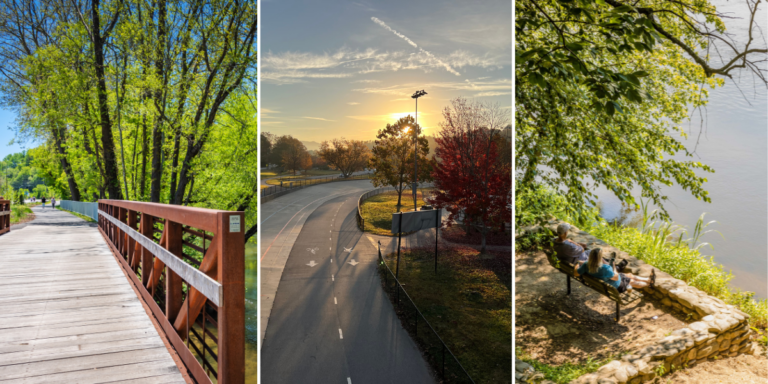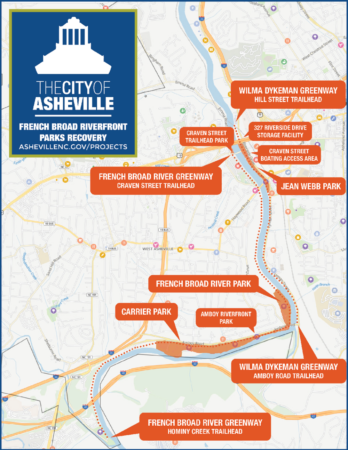The City of Asheville is taking a significant step forward in its infrastructure recovery efforts by posting a Request for Qualifications (RFQ) for design services to rebuild the parks system on the French Broad River. This milestone marks the beginning of a design plan to restore damaged City assets along the French Broad Riverfront parks system and establish a new vision for a more resilient and accessible riverfront.
The General Scope of the RFQ was informed by input received in the Helene Recovery Priorities Survey and the public engagement around the City’s Community Development Block Grant – Disaster Recovery (CDBG-DR) Action Plan.
Of the estimated $1 billion in total damages to City-owned property, Helene caused at least $25 million in destruction to the area that is home to 200+ acres of public parks, greenways and recreation facilities along the French Broad River. The project area encompasses five linear miles of frontage on both sides of the river, stretching from the western side of City limits downstream from Hominy Creek to just below the Jeff Bowen Bridge (I-240). City-owned assets in the project area include but are not limited to:
- Carrier Park
- French Broad River Park
- Amboy Riverfront Park
- Jean Webb Park
- Craven Street Trailhead Park
- Craven Street Bridge Boating Access Area
- Wilma Dykeman Greenway
- French Broad River Greenway
- 327 Riverside Drive Storage Facility
Through the RFQ process, the City of Asheville seeks to engage an experienced design team to develop a thorough design plan, including cost estimates for projects identified through engagement with residents, stakeholder groups, and partner agencies. As the project progresses, more information about community input opportunities will be made available.
Funding and Timeline
Cost recovery through federal disaster relief funding programs is essential in making this project possible. The City of Asheville seeks to accomplish this primarily through the FEMA Public Assistance Program, with significant supplemental funding from the Community Development Block Grant Disaster Relief (CDBG-DR) program. Additional funding sources may include the Hazard Mitigation Grant Program, grants from other agencies or partners, and local capital fund dollars.
The City anticipates bringing a design team on board in fall of this year. The design and public engagement process for the overall project is then expected to take two years, followed by another estimated two to three years of construction. Using a phased approach, public access will be maximized throughout the duration of the project, allowing as many amenities as possible to be open for public use.
Infrastructure Recovery: Overall Strategy
The City of Asheville is sequencing recovery projects strategically to ensure an efficient and effective rebuilding process. The kick off of the French Broad Riverfront Parks Recovery project follows RFQ postings for repairs to the Municipal Golf Course and a project to improve water treatment plants. In the near term, the community can expect the start of an additional project that encompasses City-owned assets on the Swannanoa Riverfront adjacent to Azalea Road (including but not limited to Recreation Park, Azalea Park, and the John B. Lewis Soccer Complex concession and restroom facility).
Alongside these relatively complex projects, smaller repairs are being made to other City-owned parks, streets, and facilities. Active examples include roof repairs to the Municipal Building and Thomas Wolfe Auditorium and an assessment of Historic Biltmore Village street lights damaged by the storm.
In conjunction with storm recovery efforts, the City continues to advance its Capital Improvement Plan as well as bond projects. The integration of these initiatives ensures a coordinated effort to strengthen Asheville’s infrastructure and economic stability.
Stay Informed:
Follow French Broad Riverfront Parks Recovery project updates by subscribing on the project page. Input from the community through the Recovery Priority Survey and CDBG-DR Action Plan engagement process have helped shape the City’s recovery strategy, and input opportunities will continue throughout the recovery process.
For more information on Asheville’s storm recovery, visit ashevillerecovers.org.

